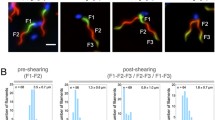Summary
The transformation ofPhysarum polycephalum flagellates to myxamoebae is characterised by disappearance of the flagellum. This transition, from the flagellate to the myxamoeba was observed by phase contrast light microscopy and recorded by time lapse video photography to determine whether flagellates shed their flagella or they are absorbed within the cell. In addition, the kinetics of flagellum disappearance were also studied. Our observations indicate that the flagellum was absorbed within the cell; the process occurred within seconds. Flagellum resorbtion was preceded by typical morphological cell changes. The shape of the nucleus altered and its mobility within the cell decreased. It was not possible to observe the flagellum within the cell with phase contrast video recordings. Thin section electron microscopy was used to study this intracellular phenomenon. Several stages of flagellum dissolution could be identified within the cell. The two most important stages were: an axoneme surrounded by the flagellar membrane within a plasma membrane lined pocket or vacuole and the naked axoneme without its membrane, free within the cell cytoplasm. The existence of cytoplasmic microtubules prevented identification of any further dissolution stages of the flagellum. A group of microtubules adjacent to the flagellum but within the cytoplasm was observed in flagellates and also in those cells which possesed enveloped axonemes. The flagellum did not dissociate from the kinetosomes before resorbtion.
Immunofluorescence studies with the 6-11-B-1 monoclonal antibody indicated that acetylated microtubules exist in myxamoebae after transformation from flagellates for up to 40 min. Acetylated tubulin is not limited to the centrioles in these cells.
Similar content being viewed by others
References
Aldrich H (1968) Development of flagella in swarm cells of the myxomycetePhysarum flavicomum. J Gen Microbiol 50: 217–222
Birkett C, Foster K, Johnson L, Gull K (1985) Use of monoclonal antibodies to analyse the expression of a multi-tubulin family. FEBS Lett 187: 211–218
Blindt A (1987) Changes in cellular organisation during apogamic development inPhysarum polycephalum. Ph. D. Thesis, University of Leicester, England, UK.
Cantino EC, Trusdell LC, Shaw DS (1968) Life history of motile spore ofBlastocladiella emersonii. A study in cell differentiation. J Elisha Michell Sci Soc 84: 125–146
Dee J, Foxon J, Anderson R (1989) Growth, development and genetic characteristics ofPhysarum polycephalum amoebae able to grow in liquid axenic medium. J Gen Microbiol 135: 1567–1588
Dingle AD, Fulton C (1966) Development of the flagellar apparatus ofNaegleria J Cell Biol 31: 43–54
Fuller MS, Reichle RE (1965) The zoospores and early development ofRhizidiomyces apophysatus. Mycologia 57: 946–961
Furtado JS, Olive LS (1970) Ultrastructure studies of protostelids. The amoeboflagellate stage. Cytobiologie 2: 200–219
Gibbons IR, Grimstone AV (1960) On flagellar structure in certain flagellates. J Biophys Biochem Cytol 7: 697–715
Hardhan AR (1987) Microtubules and the flagellar apparatus in zoospores and cysts of the fungusPhytophtora cinnamonii. Protoplasma 137: 109–124
Heath IB, Greenwood AD (1971) Ultrastructural observations on the kinetosome and Golgi bodies during asexual life cycle ofSaprolegnia. Zellforsch Mikrosk Anat 112: 371–389
Holloway SH, Heath IB (1974) Observations on the mechanism of flagellar retraction inSaprolegnia terrestris. Can J Bot 52: 939–942
Ishigami M (1977) A light and electron microscopic study of the flagellate-to-amoeba conversion in the myxomyceteStemonitis pallida. Protoplasma 91: 31–54
Koevenig JL (1964) Studies on life cycle ofPhysarum gyrosum and other myxomycetes. Mycologia 56: 170–184
Pagh K, Adelman MR (1982) Identification of a microfilament enriched, motile domain in amoeboflagellates ofPhysarum polycephalum. J Cell Sci 54: 1–21
Piperno G, Fuller M (1985) Monoclonal antibodies specific for an acetylated form of α-tubulin recognise the antigen in cilia and flagella from a variety of organisms. J Cell Biol 101: 2085–2094
Ross IK (1967) Growth and development of the myxomycetePerichaena vermicularis. I. Cultivation and vegetative nuclear division. Amer J Bot 54: 617–625
Sasse R, Glyn MCP. Birkett CR, Gull K (1987) Acetylated α-tubulin inPhysarum: immunological characterisation of the isotype and its usage in particular microtubular organelles. J Cell Biol 104: 41–49
Shoger RL, Brown GG (1970) Ultrastructural study of sperm-egg interaction of the horseshoe crab,Limulus polyphemus. J Submicrosc Cytol 2: 167–179
Tooze J (1985) Blocked coated pits in AtT20 cells result from endocytosis of budding retrovirions. J Cell Biol 101: 1713–1723
Travland LB, Whistler HC (1971) Ultrastructure ofHarpochytrium hedini. Mycologia 63: 767–789
Williams NE, Frankel J (1973) Regulation of microtubules inTetrahymena. I. Electron microscopy of oral replacement. J Cell Biol 56: 441–457
Wright M, Mir L, Moisand A (1980) The structure of the proflagellar apparatus of the amoeba ofPhysarum polycephalum: relationship to the flagellar apparatus. Protoplasma 103: 69–81
—, Moisand A, Mir L (1979) The structure of the flagellar apparatus of the swarm cells ofPhysarum polycephalum. Protoplasma 100: 231–250
Author information
Authors and Affiliations
Rights and permissions
About this article
Cite this article
Glyn, M., Gull, K. Flagellum retraction and axoneme depolymerisation during the transformation of flagellates to amoebae inPhysarum . Protoplasma 158, 130–141 (1990). https://doi.org/10.1007/BF01323125
Received:
Accepted:
Issue Date:
DOI: https://doi.org/10.1007/BF01323125



